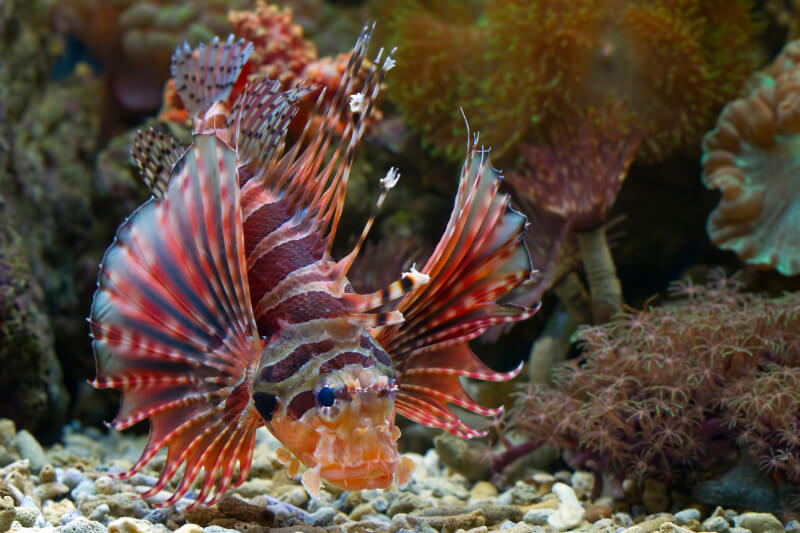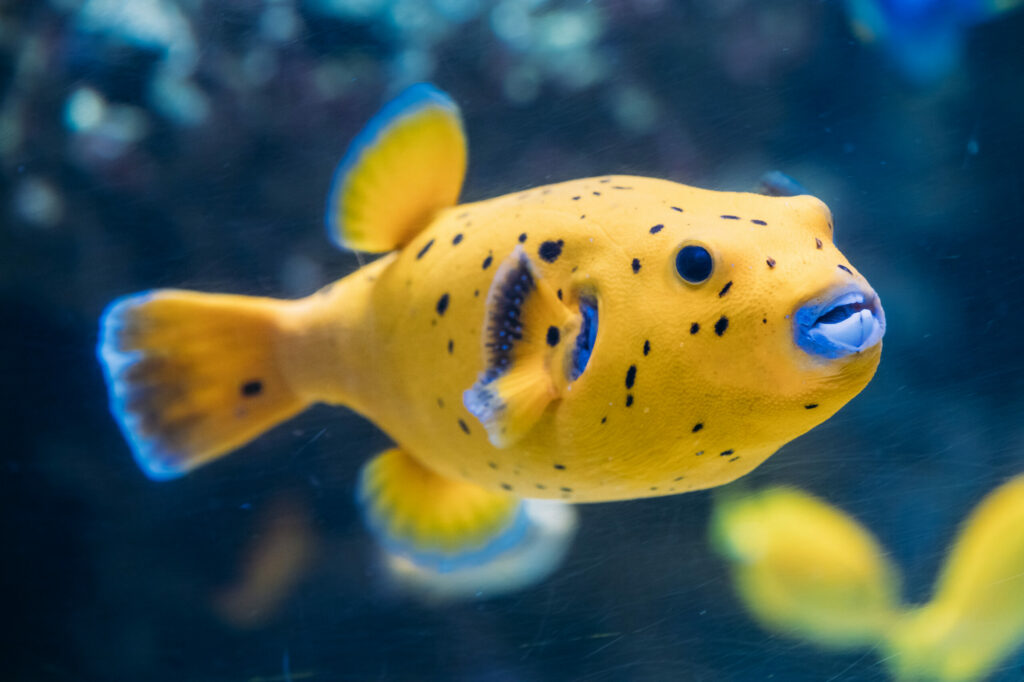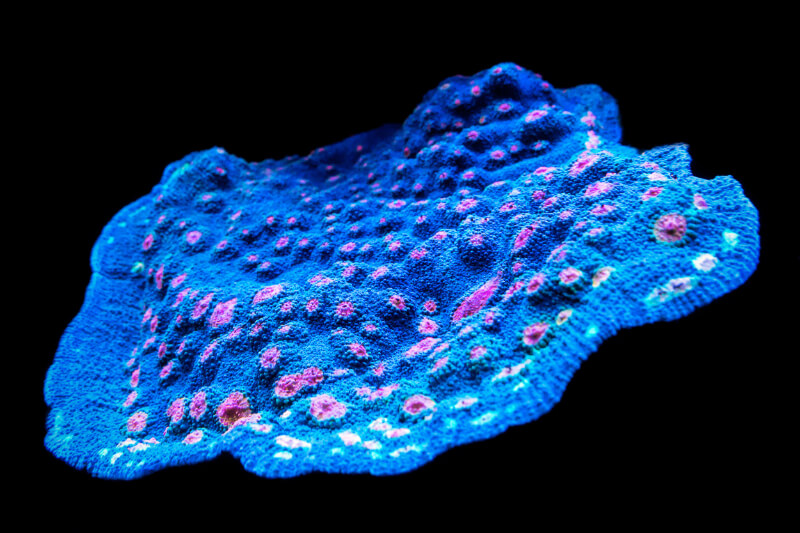Quick Facts
| Reef Safe: | Yes |
| Diet: | Crabs and brine fish |
| Tank: | 50 gallons |
| Size: | 5-7 inches |
| Behavior: | Aggressive |
| Breeding: | Difficult in captivity |
| Mates: | Large predatory species |
| Lifespan: | 10 years |
| Water temperature: | 73 to 84°F |
| pH levels: | 8.1 to 8.4 |
| Water hardness: | 8 to 12 dKH |
| Specific gravity: | 1.020 to 1.025 |
We really like the Dwarf Lionfish because these creatures are small yet mighty, boasting striking colors and unique personalities that will mesmerize any aquarium enthusiast.
In this care guide, we’ll share the essentials (and some extra) of providing a safe and nurturing environment for your Dwarf Lionfish. From tank setup and ideal companions to feeding tips and general maintenance, we’ll ensure you have all the knowledge needed to keep your little lionfish happy and healthy.
Whether you’re a seasoned aquarist or just starting, this guide will provide you with everything you need so let’s get started!
Species Summary
The Dwarf Lionfish is also known as Fuzzy Dwarf Lionfish, Turkeyfish and by its scientific name as Dendrochirus brachypterus. Wild Dwarf Lionfish are found in the Indo-Pacific waters of Samoa, Tonga, eastern Africa, and the Red Sea.
They prefer rocky areas full of crustaceans, invertebrates, and fish that can help to satisfy their carnivorous appetites! In fact, it’s the aggressive appetite of the Dwarf Lionfish that can make this species so difficult to pair with other tank mates. The general rule is that anything that can fit inside a Dwarf Lionfish’s mouth will make its way to its stomach.
While beautiful and elegant, these tiny members of the Scorpion Fish family are considered common in tanks due to the fact that they are one of the most exotic fish species to be so readily available for purchase. However, expertise is needed when handling this somewhat aggressive fish with dual penchants for hunting and self-protection. Even humans are at risk when handling these deceptively plush-looking beauties!
Author Note: Tank keepers must always use caution to avoid the venomous spikes of the Dwarf Lionfish when placing their hands inside aquariums. All 13 dorsal fins of the Dwarf Lionfish are linked to its venom glands. The sting of a Dwarf Lionfish is comparable to a sting from a bee.
Appearance
You’ll know you’re looking at a Dwarf Lionfish when you see frilly fins over a striped-scale body. Most are colored silver, black, or red. This fish’s vibrant pectoral fins tend to show brighter than the rest of the body. One distinctive feature is a short tentacle above the eye.
Popular Lionfish
Like many popular aquarium fish, the Dwarf Lionfish comes in a number of different varieties. Here’s a look at the most popular picks for aquariums!
- Fu Man Chu Lionfish (Dendrochirus biocellatus). Also called the Twinspot Lionfish or Ocellated Lionfish, the Fu Man Chu Lionfish is identified by a set of red, white, and black vertical stripes painting its body. A long, quill-shaped dorsal fin helps to define the Fu Man Chu’s shape. Additionally, this fish’s dramatic, fan-like pectoral fins stand out in the water. What makes the Fu Man Chu Lionfish instantly distinguishable from the traditional Dwarf Lionfish is a set of two feeler-type appendages fixed to the chin.
- Dwarf Fuzzy Lionfish (Dendrochirus brachypterus). While this venomous creature is anything but cuddly, the Fuzzy Dwarf Lionfish is beloved around the world as a top aquarium pet. In fact, the Dwarf Lionfish is the variety that most people picture when they talk about the Lionfish. This particular variety gets its name from its full, slightly fluffy fins. The body of the Dwarf Fuzzy Lionfish is covered in red, white, and black vertical stripes. Fan-like fins balanced by quill-shaped dorsal fins can also be observed.
- Dwarf Zebra Lionfish (Dendrochirus zebra). The Dwarf Zebra Lionfish has the classic red, white, and black vertical stripes of this species along its body. It also displays the signature fan-like and quill-shaped fins that are signatures of the Dwarf Lionfish. These fish have been known as solitary predators but recently they have been seen in groups of 2 or 3 in the wild and in captivity to hunt and live together.
- Hawaiian Lionfish (Pterois sphex). You can typically spot a Hawaiian Lionfish by looking for irregular white and brown vertical bars located on the flanks. They are usually hiding during the day and emerge at night to feed on crustaceans and small fish. These fish are commonly found in lagoons and reefs scattered throughout Hawaii’s islands.
Lifespan
The average lifespan of the Dwarf Lionfish is 10 years. Of course, maintaining a clean, safe tank is essential for helping your fish to live a long, fulfilling life.
Average Size
While the Dwarf Lionfish can grow to be 5 to 7 inches, this fish tends to max out at 5 inches in captivity. Its relatively small size makes it a great choice for smaller aquariums especially since it is easier to handle than other lionfish.
Dwarf Lionfish Care
Known for their hardy reputation, Dwarf Lionfish are generally considered one of the easier fish to care for because they aren’t active swimmers. However, they do need specific tank conditions in order to thrive.
Tank Size
While the Dwarf Lionfish only needs 29 gallons to thrive, a 50-gallon tank is recommended. If you can go a bit bigger it would be better so they can have plenty of spaces to hide. Just make sure not to get confused with the red lionfish (Pterois volitans) since this fish can grow as much as 18 inches.
Water Parameters
- Water temperature: 73 to 84°F
- pH levels: 8.1 to 8.4
- Water hardness: 8 to 12 dKH
- Specific gravity: 1.020 to 1.025
Tank Setup
Plan to pack in lots of hiding spots for your Dwarf Lionfish. These fish prefer to seek shelter in rocks and corals over swimming around. As a bottom-dwelling fish, the Dwarf Lionfish appreciates a good substrate.
Lighting
Bright lights can stress Dwarf Lionfish. For this reason, it’s recommended that you use only subdued lighting when setting up a tank.
Filtration
Dwarf Lionfish don’t have any special filtration needs beyond the ordinary need to control ammonia spikes in the tank. A good skimmer is considered especially important with Dwarf Lionfish because this can help to remove larger particles before they build up on the substrate where these fish spend most of their time.
Acclimation
The Dwarf Lionfish doesn’t require any special steps for acclimation. However, tank owners should be prepared for the fact that these fish are notoriously shy when introduced into new environments.
Don’t be surprised if your new fish hides behind rocks for the first few days. Over time, you may notice the fish becoming friendly and curious when you show up for feeding time.
Author Note: Introducing a Dwarf Lionfish to a tank that already has adult, full-sized tank mates that outsize their new neighbor is advisable for helping to prevent this fish’s habit of snacking on anything that’s even slightly smaller.
Are Dwarf Lionfish Reef Safe?
Yes, Dwarf Lionfish are technically reef-safe fish. While their carnivorous appetites can make them aggressive toward some tank mates, the Dwarf Lionfish has no interest in coral.
Author Note: There is the chance that coral could become collateral damage while this fish is busily hunting around the tank.
Common Possible Diseases & Prevention
The Dwarf Lionfish is famously resistant to illness and disease. While it’s uncommon for this fish to become ill, fin rot and ich both pose risks. It’s best to isolate new fish in quarantine to look for signs of illness before introducing them to your communal tank.
Food & Diet
Keeping this fish properly fed is one of the hardest aspects of keeping this species since it is notoriously hungry and aggressive. The Dwarf Lionfish loves eating crustaceans and invertebrates above all else! However, you can expect yours to eat anything in the tank that can fit in its mouth.
Generally, the diet of a Dwarf Lionfish in captivity consists of live small crabs and brine fish that are supplied by the tank keeper. You may also find that your Dwarf Lionfish is satisfied by frozen versions. Lobster tails and squids are some other options.
Author Note: It’s also important to make sure that food that is placed in the tank for your Dwarf Lionfish is highly visible because it can be hard for these hiders to see items from their rocky crevices. Most experts recommend feeding Dwarf Lionfish just three days a week to help prevent obesity.
Behavior & Temperament
The Dwarf Lionfish has one of the most interesting personalities you’ll ever observe in an aquarium. First, these fish like to make themselves scarce. They love nothing more than to camouflage their bodies within rocky structures. They are also known to blend in with a tank’s rocky or sandy substrate.
Dwarf Lionfish are agile crawlers who love to move around nearly undetected which is a skill not used very often (mostly when they’re scared). The reason for this characteristic is that the Dwarf Lionfish sneaks up on its unsuspecting prey. Therefore, there’s no need for this fish to chase its prey when it executes the element of surprise so perfectly to its own advantage.
Author Note: A Dwarf Lionfish is perfectly happy being a solitary creature and while it’s acceptable to house this fish with tank mates, it’s important to be aware of the Dwarf Lionfish’s aggressive personality. Other aggressive fish can usually defend themselves against the Dwarf Lionfish as long as they don’t fit in their mouth!
If you do not see lots of movement please keep in mind that the Dwarf Lionfish is notoriously sedentary during the day and active at night.
Is the Dwarf Lionfish a Poisonous Creature?
Yes! The Dwarf Lionfish releases poisonous venom when threatened. While you are unlikely to experience more than a throbbing sting if your hand touches this fish, some people could have dangerous allergic reactions.
It’s wise to seek medical attention if you’re stung by a Dwarf Lionfish. You should know that even handling a deceased Dwarf Lionfish can be dangerous because involuntary venom release can still occur!
Dwarf Lionfish Tank Mates & Predators
Be aware that a Dwarf Lionfish will happily eat any smaller fish that can fit into its mouth! Generally, a Dwarf Lionfish works best with other large predatory species.
Tank mates that are commonly paired with the Dwarf Lionfish include Moray Eels, Triggerfish, Pufferfish, and Rabbitfish. While these fish can generally hold their own against the Dwarf Lionfish, safety is not guaranteed if you end up with a particularly aggressive fish.
Some fish that are considered highly compatible for the tricky Dwarf Lionfish include:
Expect your Dwarf Lionfish to make a meal of any smaller fish in no time at all! Additionally, the Blennies, Damsels, Gobies, and other popular medium-sized fish that are common in communal tanks can still be small enough to slip inside a Dwarf Lionfish’s mouth. It goes without saying that crustaceans, crabs, and shrimp are all poor companions because they are some of the Dwarf Lionfish’s favorite menu items!
Author Note: While Dwarf Lionfish will form schools, they are also quite content to be on their own. The exception is the Fu Manchu Dwarf Lionfish. When grouped together, Fu Manchu Dwarf Lionfish tend to pick at one another.

Breeding
Dwarf Lionfish are relatively easy to keep but notoriously difficult to breed in captivity. If you aspire to own a breeding pair, providing ample space for making the couple feel comfortable enough to breed is essential. Successful breeding usually requires an aquarium keeper to keep groups of males and females.
One of the reasons why breeding Dwarf Lionfish can be so difficult is that it’s very hard to tell males and females apart. With some practice and a good eye you might be able to notice the following subtle differences:
| Male | Female |
| Larger, broader body (typically) | Smaller head that generally slopes more |
| More pronounced pectoral fins | Once she is ready to breed she will begin to carry eggs |
| Generally initiate breeding by hunting for females | She will begin to form an interest in a single male |
Author Note: After fertilization, the gelatin-like eggs that are carried by the female Dwarf Lionfish will begin to hatch in just 36 hours!
Wrapping Up
So, what did you think? We hope this guide provided you with enough information to succeed with your Dwarf Lionfish and if you don’t have one, maybe now you are confident to move forward with your first lionfish!
Always keep in mind that these magnificent creatures are poisonous, aggressive towards smaller fish and usually hide during the day. Therefore, providing a safe and nurturing environment is key to ensuring the well-being of your dwarf lionfish so you can witness their vibrant colors and charismatic behavior for years to come.
In case you are looking for more knowledge about other fish try our Saltwater Care Guides, and don’t forget to tag us on Facebook when sharing a cool photo of your lionfish!




